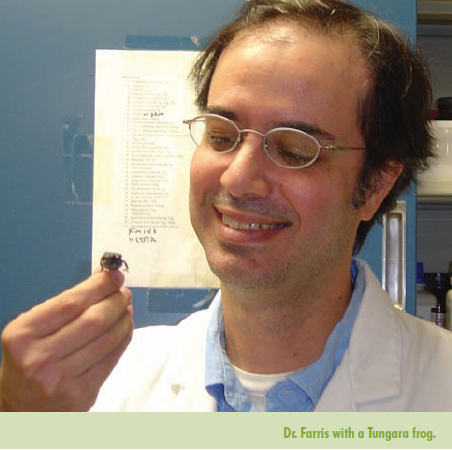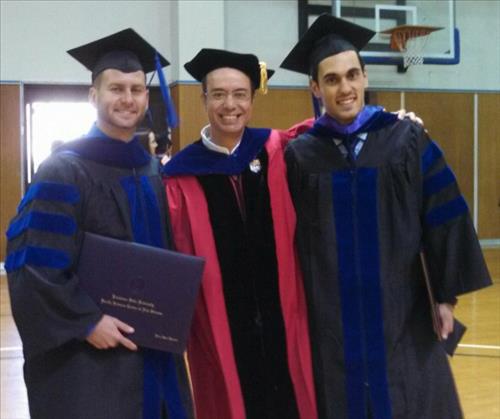
Hamilton Farris, Ph.D.
Hamilton Farris, Ph.D.
Assistant Dean of Student Affairs and Records
Associate Professor
Neuroscience Center
Dept. Cell Biology and Anatomy
Dept. Otorhinolaryngology and Biocommunication
Assistant Dean of Student Affairs and Records
Associate Professor
Neuroscience Center
Dept. Cell Biology and Anatomy
Dept. Otorhinolaryngology and Biocommunication
Mailing Address:
Neuroscience Center
LSUHSC
2020 Gravier St.
New Orleans, LA 70112Phone:
Lab: 504-599-0865Email:
hfarri@lsuhsc.edu
Degrees
2002-2006: Postdoc, LSUHSC
2000-2002: Postdoc, University of Texas-Austin
1994-2000: Ph.D., Cornell University (Neurobiology & Behavior)
Bio
Awards/Recognitions/Lectures:
2014 Allen A. Copping Excellence in Teaching Award, School of Medicine LSUHSC
2009 Grass Faculty Award. Marine Biological Laboratory
2005-2006: NRSA Individual Postdoctoral F32 Fellowship LSUHSC
2003-2005: NRSA Individual Postdoctoral F32 Fellowship LSUHSC
1998: Best Student Paper; 16th International Congress on Acoustics and the 135th meeting of the Acoustical Society of America. Seattle, WA. USA
1995-2000: NIMH integrative training grant fellowship, Cornell University
Local medical research team makes breakthrough in curing deafness
WWLTV.com, February, 4 2013. link to page
Clinical Interests
Associate Editor for Basic Science
Journal of the Neurological Sciences
Associate Editor for Insect Neurobiology
Research Interests
Keywords:
communication, speech, attention, complex auditory stimuli
Using the methodologies of psychophysics, neurophysiology and evolutionary biology, our research explores the underlying neural mechanisms mediating sensory acuity (i.e., stimulus detection and discrimination). Our long-range goal is to understand how components of descending circuitry contribute to the ability to communicate in noisy environments.
Field work at the Smithsonian Tropical Research Institute
"Singing in the Rain" by Leslie Capo
Research Saves, Spring 2010
Teaching Activities

Dr. Hamilton Farris (center) with new Ph.D. graduates,
Eric Knott, (left) and Aram Asatryan (right)
Course Coordinator:
Inter 132 (Neuroscience Block: Director)
Medical Neuroscience (Course Director)
Psychoacoustics (Course Director)
Lecturer :
Allied Health Neuroscience ; Investigative Neuroscience ; Molecular Neuroscience ; Synaptic Organization of the Brain
Selected Publications
Walkowski, WG, Richards-Zawacki, CL, Gordon, WC, Bazan, NG, Farris, HE. (2024) The relationship between spectral signals and retinal sensitivity in dendrobatid frogs. PLOS ONE. https://doi.org/10.1371/journal.pone.0312578
Ponnath, A, Ryan, MJ, Fang, Z, Farris, HE. (2022) Tuned in to communication sounds: neuronal sensitivity in the túngara frog midbrain to frequency modulated signals. PLOS ONE. https://doi.org/10.1371/journal.pone.0268383
Leslie, CE, Walkowski, W, Rosencrans, RF, Gordon, WC, Bazan, NG, Ryan, MJ, Farris, HE. (2021) Estrogenic modulation of retinal sensitivity in reproductive female túngara frogs. Integrative & Comparative Biology, icab032, https://doi.org/10.1093/icb/icab032 Link
 |
Lentz JJ, Pan B, Ponnath A, Tran CM, Nist-Lund C, Galvin A, Goldberg H, Robillard KN, Jodelka FM, Farris HE, Huang J, Chen T, Zhu H, Zhou W, Rigo F, Hastings ML, Géléoc GSG (2020) Direct delivery of antisense oligonucleotides to the middle and inner ear improves hearing and balance in Usher mice. Molecular Therapy. doi: https://doi.org/10.1016/j.ymthe.2020.08.002 Link |
Leslie, CE, Rosencrans, RF, Walkowski, W, Gordon, WC, Bazan, NG, Ryan, MJ, Farris, HE. (2020) Reproductive state modulates retinal sensitivity to light in female túngara frogs. Front. Behav. Neurosci. 13:293. doi: 10.3389/fnbeh.2019.00293 Link
Rosencrans RF, Leslie CE, Perkins KA, Walkowski W, Gordon WC, Richards-Zawacki CL, Bazan NG, Farris HE. (2018) Quantifying the relationship between optical anatomy and retinal physiological sensitivity: A comparative approach. Journal of Comparative Neurology, 1–13. https://doi.org/10.1002/cne.24531 Link
Ponnath, A., Depreux, F., Jodelka, F., Rigo, F., Farris, H.E., Hastings, M., Lentz, J. (2018) Rescue of outer hair cells with antisense oligonucleotides in Usher mice is dependent on age of treatment, Journal of the Association for Research in Otolaryngology. DOI: 10.1007/s10162-017-0640-x Link
Farris, H.E. and Ryan, M.J. (2017) Schema vs. primitive perceptual grouping: The relative weighting of sequential versus spatial cues during an auditory grouping task in frogs, Journal of Comparative Physiology A. DOI 10.1007/s00359-017-1149-9 Link
Farris, H.E. (2017) Perception drives the evolution of observable traits. Science Vol. 355, Issue 6320, pp. 25-26 DOI: 10.1126/science.aal4193 PDF / Link (Perspective paper)
Farris H.E. and Taylor, R.C. (2016) Mate Searching Animals as Model Systems for Understanding Perceptual Grouping. In Psychological Mechanisms in Animal Communication (eds: Bee, M; Miller, C). Book series Animal Signals and Communication (series eds: McGregor, PK and Janik, VM). Springer International Publishing, New York, p. 89-118. Link
Ponnath, A and Farris H.E. (2014). Sound-by-sound thalamic stimulation modulates midbrain auditory excitability and relative binaural sensitivity in frogs. Front. Neural Circuits 8:85. doi: 10.3389/fncir.2014.00085 Link
Imaizumi, K., Shih, J.Y. and Farris, H.E. (2013) Global hyper-synchronous spontaneous activity in the developing optic tectum. Scientific Reports doi:10.1038/srep01552 (nature.com link)
Lentz, J., Jodelka, F, Hinrich, A., McCaffrey, K., Farris, H.E., Spalitta, M., Bazan, N., Duelli, D., Rigo, F., Hastings, M. (2013) Rescue of hearing and vestibular function by antisense oligonucleotides in a mouse model of human deafness. Nature Medicine doi:10.1038/nm.3106 Link
Press and editorials for Lentz et al.:
Ponnath, A., Hoke, K. and Farris, H.E. (2013) Stimulus change detection in phasic auditory units in the frog midbrain: frequency and ear specific adaptation. Journal of Comparative Physiology A doi:10.1007/s00359-013-0794-x Link
Jones, P., Farris, H.E., Page, R., Ryan, M. (2013) Do frog-eating bats perceptually bind the complex components of frog calls? Journal of Comparative Physiology A doi: 10.1007/s00359-012-0791-5 Link
Akre, K.L., Farris, H.E., Lea, A.M., Page, R.A., and Ryan, M.J. (2011) Signal perception in frogs and bats and the evolution of mating signals. Science. 333 (6043):751-2. Link
Press and editorials for Akre et al.:
Farris, H.E., and Ryan, M.J. (2011) Relative comparisons of call parameters enable auditory grouping in frogs. Nature Communications. Vol. 2: doi: 10.1038/ncomms1417. Link
Ponnath, A. and Farris, H.E. (2010) Calcium-dependent control of temporal processing in an auditory interneuron: a computational analysis. Journal of Comparative Physiology A. 196: 613–628. Link
Lentz, L. Gordon W.C. Farris, H.E., MacDonald, G. Robbins, C.A., Tempel, B.L., Bazan, N.G., Rubel, E., Oesterle, E., Keats, B. (2010) Deafness and retinal degeneration in a novel USH1C knock-in mouse model. Developmental Neurobiology, 70:253-67. Link
Farris, H.E., Oshinsky, M., Forrest, T., and Hoy, R.R. (2008) Auditory sensitivity of an acoustic parasitoid (Emblemasoma sp., Sarcophagidae, Diptera) and the calling behavior of potential hosts. Brain , Behavior and Evolution, 72:16-26. Link
Farris, H.E., Wells, G.B. and Ricci, A.J. (2006) Steady-state adaptation of mechanotransduction modulates the resting potential of auditory hair cells, providing an assay for endolymph [Ca2+]. Journal of Neuroscience.26, 12526-12536. Link
Farris, H.E., Rand, A.S. and Ryan, M.J. (2005) The effects of time, space and spectrum on auditory grouping in túngara frogs. Journal of Comparative Physiology A. 191, 1173-1183. Link
Farris, H.E., and Ricci, A.J. (2005) Voltage-clamp errors cause anomalous interaction between independent ion channels.Neuroreport,16, 943-947. Link
Witte, K., Farris, H.E., Ryan, M. and Wilczynski, W. (2005) How cricket frog females deal with a noisy world: habitat-related differences in auditory tuning.Behavioral Ecology, 16, 571–579. Link
Farris, H.E., LeBlanc, C.L., Goswami, J. and Ricci, A.J. (2004) Probing the pore of the auditory hair cell mechanotransducer channel in turtle. Journal of Physiology, 558.3, 769-792. Link
Wyttenbach, R. and Farris, H.E. (2004) Insect psychoacoustics. Microscopy Research and Technique, 63, 375-387. Link
Farris, H.E., Mason, A.C. and Hoy, R.R. (2004) Identified auditory neurons in the cricket Gryllus rubens: temporal processing in calling song sensitive units. Hearing Research,193, 121-133. Link
Farris, H.E., Rand, A.S. and Ryan, M.J. (2002). The effects of spatially separated call components on phonotaxis in túngara frogs: Evidence for auditory grouping.Brain, Behavior and Evolution.60, 181-188. Link
Farris, H.E., and Hoy, R.R. (2002) Two-tone suppression in the cricket, Eunemobius carolinus (Gryllidae, Nemobiinae). Journal of the Acoustical Society of America,111, 1475-1485. Link
Farris, H.E.,and Hoy, R.R. (2000). Ultrasound sensitivity in the cricket, Eunemobius carolinus (Gryllidae, Nemobiinae). Journal of the Acoustical Society of America, 107, 1727-1736. Link
Farris, H.E., Forrest, T.G. and Hoy, R.R. (1998). The effect of ultrasound on the attractiveness of acoustic mating signals. Physiological Entomology, 23, 322-328. Link
Farris, H.E., Forrest, T.G. and Hoy, R.R. (1997). The effects of calling song spacing and intensity on the attraction of flying crickets (Orthoptera: Gryllidae: Nemobiinae). Journal of Insect Behavior, 10, 639-653. Link
Forrest, T.G., Read, M.P., Farris H.E., and Hoy R.R. (1997). A tympanal hearing organ in scarab beetles. Journal of Experimental Biology, 200, 601-606. Link
Forrest, T.G., Farris, H.E. and Hoy, R.R. (1995). Ultrasound acoustic startle response in scarab beetles. Journal of Experimental Biology,198, 2593-2598. Link
Additional Info
Lab Web Page (under construction)

 myLSUHSC
myLSUHSC

